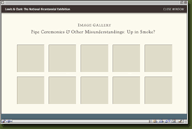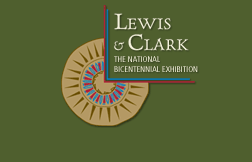
IMAGE GALLERY
 |
 |

Access the Image Gallery to see all images, objects, and documents used in this lesson plan.
 |
View Image Gallery

|

|
 |



Lesson Plan 1: Imagining America
OBJECTIVES
Students will:
- be able to study historic maps to discover what was known of the North American interior by different people prior to the Lewis and Clark expedition
- using the maps, source materials, and worksheets students will, through analyzing, comparing, contrasting, and synthesizing, be able to understand that what is known about a destination shapes how one prepares for the journey to that destination
MATERIALS
BACKGROUND
Lessons 1 and 2 examine reasons for the Lewis and Clark expedition. This lesson looks at an 1802 map of North America and a reading about Jefferson's "imagined" West.
OPENING
- Ask students why they think Jefferson planned the Lewis and Clark expedition.
- Make a list of ideas. This exercise is meant to help the teacher assess the students' base knowledge of the expedition.
PROCEDURE
- Distribute a copy of the blank map to each student.
- Distribute the Arrowsmith map to each student, or project on an overhead. This British map was the best available to Lewis, who used it to plan the expedition.
- Students should examine the map carefully and make a list of what is known about North America. Add these features to the blank map.
- Place Jefferson's quotes on the board or overhead projector, or distribute copies.
Jefferson's Views on Western River Systems
From Finding the West by James P. Ronda:
"'The Missouri is the principal river, contributing more to the common stream than does the Mississippi.'"
"'As a channel of communication between these states and the Pacific Ocean, the Missouri, so far as it extends, presents itself under circumstances of unquestioned preference.'" (p. 9)
"'It would seem by the latest maps as if a river called Oregon interlocked with the Missouri.'" (p. 9)
From Jefferson's instructions to Lewis, June 20, 1803:
"The object of your mission is to explore the Missouri river, and such principal stream of it, as, by it's course and communication with the waters of the Pacific ocean, whether the Columbia, Oregon, Colorado or any other river may offer the most direct and practicable water communication across the continent for the purposes of commerce."
"Altho' your route will be along the channel of the Missouri, yet you will endeavor to inform yourself, by enquiry, of the character & extent of the country watered by it's branches, & especially on it's Southern side. The North river or Rio Bravo [Rio Grande] which runs into the gulph of Mexico, and the North river, or Rio colorado which runs into the gulph of California, are understood to be the principal streams heading opposite to the waters of the Missouri, and running Southwardly. Whether the dividing grounds between the Missouri & them are mountains or flat lands, what are their distance from the Missouri, the character of the intermediate country, & the people inhabiting it, are worthy of particular enquiry."
- Have students read the quotes and fill in their map showing what Jefferson believed existed in the unknown territory.
- Organize students into groups where they compare their answers and construct a group summary and present it. Discuss their responses.
- Distribute the Student Reading "Imagining America" and have students read it within the group. The reading refers to Nicholas King's map, and students should look at this map. After they have read it, have each group make a list of 1) possible reasons why Jefferson was interested in an expedition and 2) Jefferson's ideas about the West.
- Optional Online Activity: Take a Closer Look. This activity allows students to analyze three maps that Lewis and Clark most likely used to prepare for the expedition. All three show the northwestern United States, from St. Louis to the Pacific. The activity includes questions to help direct student analysis. The maps demonstrate what was and wasn't known about the western part of the continent.
CLOSING
Looking at the original list from the opening exercise, have students compare their new lists with the original list, and add Jefferson's reasons to the original list, marking them with a "TJ."
Look at a modern map of North America and consider what is known today.
End with the question: how would the "imagined America" impact how one would prepare for an expedition across the continent?
It is important to note that Jefferson had other reasons for the expedition other than those related to geographical knowledge. Lesson 2 explores some of these.
[PRINTABLE VERSION]
|
 |






